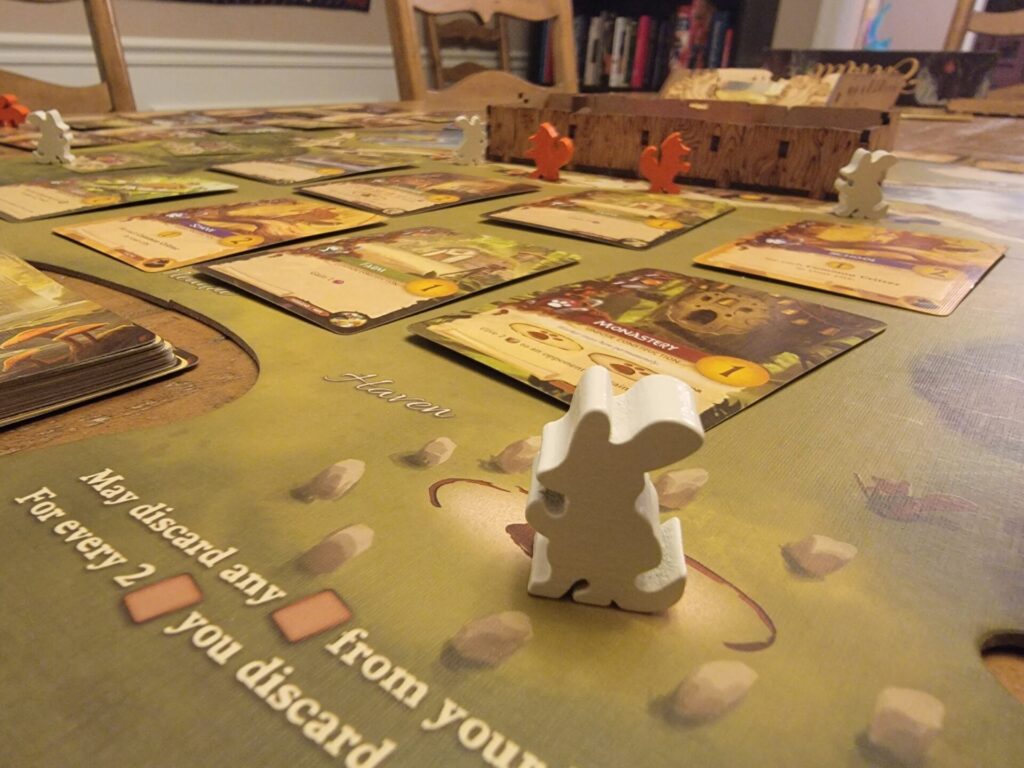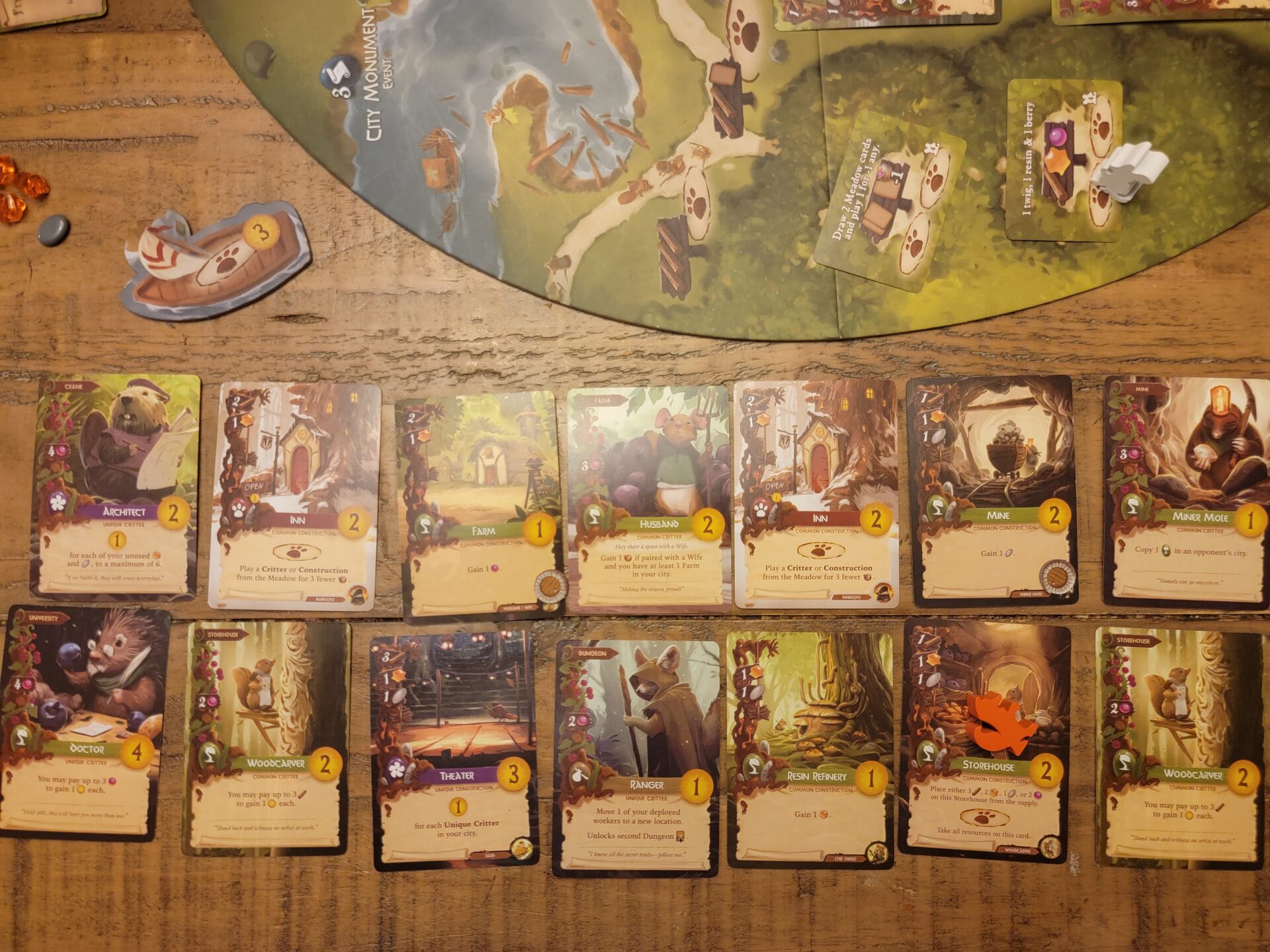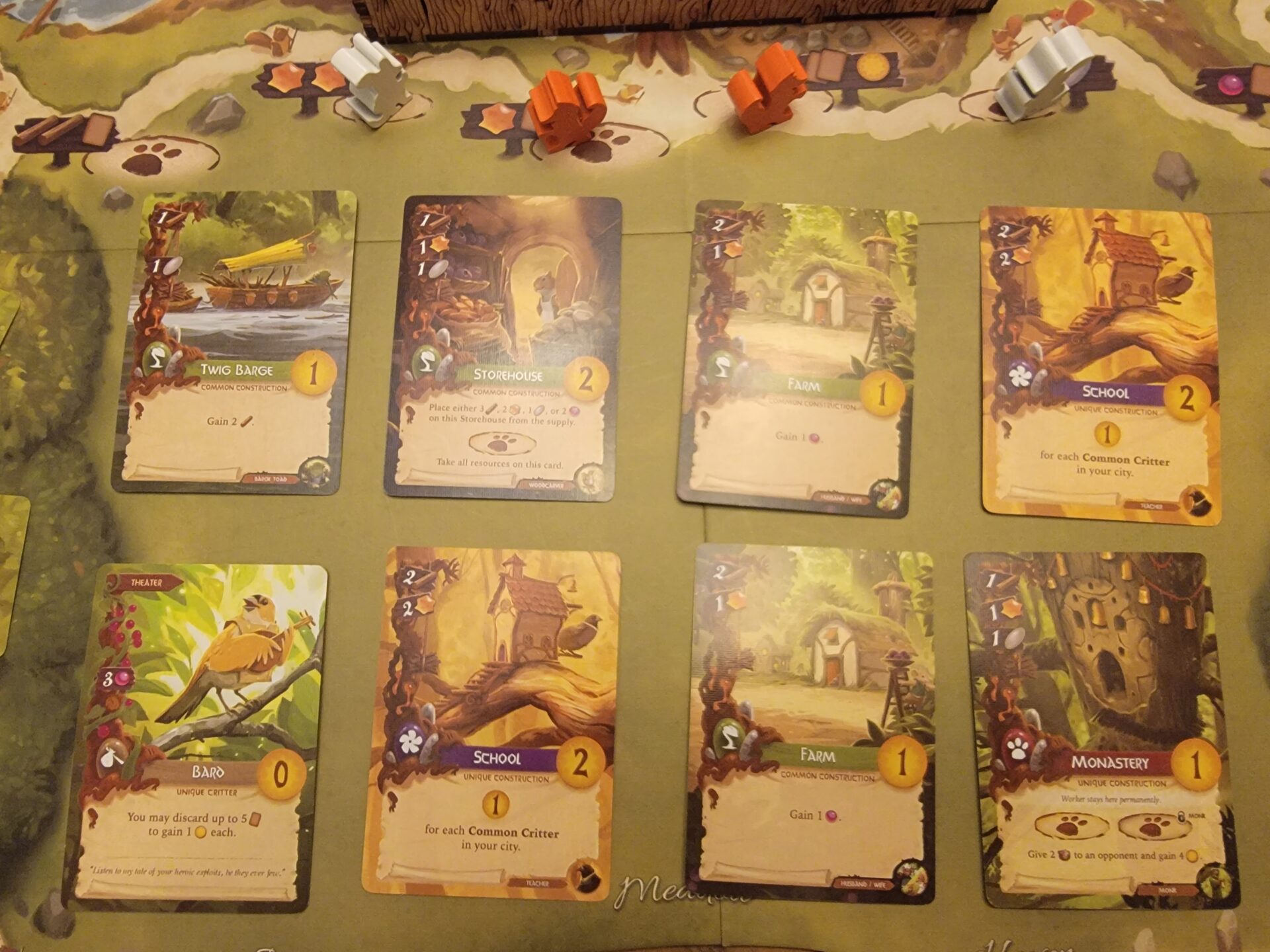
Name: Everdell
Year of Release: 2018
Player Count: 1 – 4 Players
Playing Time: 40 – 80 minutes
Designer: James A. Wilson
Publisher: Starling Games
Primary Mechanisms: Hand Management, Worker Placement, Open Drafting, Tableau Building
Weight (According to boardgamegeek.com): 2.81
Note this review contains pictures that include the 3rd party insert created by Tower Rex. If you are interested, please visit their Etsy website here to support a small business located in Ukraine!
Overview
I’ve been holding off on writing an Everdell review for two reasons. First, who really needs another Everdell review in the year 2022? (Aside: that last sentence reminds me of a wonderful Father John Misty lyric found in his song Leaving LA from 2017. “She’s like, ‘Oh great, that’s just what we all need / Another white guy in 2017 / Who takes himself so … seriously.’”) This game has had plenty of exposure and numerous fans spread across the globe so what could I possibly say that hasn’t already been said? Second reason being, this is probably my favorite game (possibly 1A and 1B with Viticulture) and the weight of that fanboy-ism is weighing heavily on me. But today is the day I throw off those chains and discuss my love for this game!
I did, however, want to do something slightly different for this game so this will be the first in a small series of reviews featuring the world that is Everdell. In this first review, I will lay out the basics of the game and cover what I like and don’t like in the base game. Then there will be subsequent reviews detailing the expansions Bellfaire (click here) and Spirecrest (click here), and how they alter the base game. Lastly, you can click here for a piece of prose that I originally posted on boardgamegeek.com that was inspired by a single playthrough of the Spirecrest expansion.
Sadly, I do not own the first expansion they released, called Pearlbrook, so I will not be able to discuss that in this venue. But please, feel free to leave any comments on the site about your thoughts on Pearlbrook for those readers who might be interested (and who might somehow get lucky on finding a copy in the wild.)
With that introduction out of the way, let’s make like Corrin Evertail and get a move on through the valley to the majestic Ever Tree and the splendor that is Everdell.
Setup

So, let’s get this out of the way: I no longer use the grandiose tree that shipped with the game. It is not very functional and was primarily created (in my opinion) to look nice in pictures and draw people to the game. It is also starting to fall apart and is a pain to even put together at this point, so it has been relegated to one of the unused expansion boxes in the closet. If you love the tree and couldn’t imagine playing the game without it, more power to you but for me and this review, the tree no longer holds any merit.
For those of you who have decided to stick around after the hottest take of hot takes above, the setup for the base game is fairly easy, taking anywhere between 10 and 15 minutes. For the most part, the setup revolves around a few different decks of cards that need to be shuffled, a handful of animal meeples, and a collection of resources.
Like a lot of modern board games, Everdell’s setup has multiple variables, giving each play a different feel. The first variable is found in the small deck of Forest cards. On the board there are eight different action locations printed that will never change from game-to-game but to the south of these action locations, there are four empty spots to house four of the Forest cards. These cards are shuffled and three or four (depending on player count) are turned over and placed in the four empty locations. I really enjoy this part of the game as it can definitely change your strategy on how you will gather and use resources. A great example would be that on the board, there is only one location printed for you to get a pebble resource. In one game, one of the Forest cards might be unveiled that also awards you a pebble. The way you must think through gaining resources in that play is going to be vastly different from one in which the Forest cards award you no pebbles and everyone is fighting for the printed pebble location.
The second set of variables during setup has to do with the Special Event card. This is a deck of cards that gives the players a certain set of criteria (such as having both the Doctor card and the Postal Pigeon card in their city) and once that criteria is met, a worker can be placed there for that player to pick up the Special Event card. Typically, these cards give the player victory points at the end of the game but other times they also award a special action to take place at the time the event was gained. While I enjoy the fact that each setup has four different cards, I don’t care for the events themselves and how they are predicated on having two certain cards in your city to gain the event. To me, this leaves it entirely up to luck as sometimes the needed cards don’t ever even show up during the game.
After these cards are placed where they need to be, the players will set out the piles of resources on their specific locations on the board. The resources include twigs, resin, pebbles, and berries. Next, make two separate piles of the victory point tokens and the Occupied Tokens so that all players can reach them. Grab the four Basic Event Tiles and place them in the required spots marked on the board and then comes the most important part of setup and I want to stress just how important this next step is for all those that have never played the game.
It is time to choose your animal type and collect the six tiny, cute animal meeples that represent your creature type! Ok, maybe it’s not that important but who doesn’t like animal meeples!? In the base game, you receive four animal types: hedgehogs, mice, squirrels, and turtles. Two of these worker tokens are placed into your supply and the rest are placed off to the side to be used during the Prepare for Season phase.
Lastly, take the whopping deck of 128 cards (featuring both Critter cards and Construction cards), shuffle it up and then place eight face-up cards in the center of the board to form the Meadow. You will then deal out five cards to the first player, and increase the number of cards given by one, moving clockwise around the table. These cards will form the starting hand for each player. With that all being completed, the game is ready to be played!
Components

As you can probably guess from photos of Everdell, the production is top-notch. Outside of the aforementioned Ever Tree stand, everything else contained within the game is of the highest quality.
The resources are all different shapes, different sizes, and even produced from different materials. The meeples are all shaped (and colored to a certain extent) to represent their necessary animal type. The artwork on each card is gorgeous, giving off the perfect feel for a theme about anthropomorphic creatures building a city. The rulebook is easy to understand, printed with plenty of photos and examples to clear up any misconceptions one might have. I like that at both the beginning and end of the rulebook, they’ve taken the time to print some story-related elements on how the place of Everdell came to be. While they are definitely not needed to enjoy the game, these small world-building details add to the overall theme while playing.
All-in-all, there isn’t much I can complain about when it comes to the game’s components so let’s move on to the real substance of the game, the gameplay.
Gameplay

Everdell hits that sweet spot for me where multiple mechanics are seamlessly intertwined with each other, allowing the game to flow naturally from one turn to another. On a player’s turn they will either take a worker action or they will play a card into their tableau. They might also decide to Prepare for Season but this is only going to be done once a season so we will discuss this phase later in the gameplay section.
If a player decides to take a worker action, they will take one of their available meeples and place them on an action location, triggering that location. Some of the locations on the board allow for multiple meeples to inhabit but most of them are only going to allow one meeple at a time. This adds some nice competition for spots between players but it’s not really doing anything different from a lot of other worker placement games out there. What is slightly different, and that I really enjoy, is that there is no action to “buy” more workers as each player will naturally earn more players as they progress through the seasons. In some worker placement games, I find that everyone is almost forced into competing for the action location that gives them more workers. You also never have to “feed” your workers (like you do in Agricola or Tzolk’in: the Mayan Calendar) which allows you to focus solely on actions that will build up your city thus generating points at the end of the game.
On the flip side, if a player doesn’t want to take a worker action, or is out of workers, they can play a card into their tableau. To do this, a player must have the necessary resources listed on either the card in their hand, or one of the eight cards in the meadow. The player turns in those listed resources, and then places the card into their city. There are five different types of cards, each doing something different once the card is played.
- Tan Traveler cards are immediately activated once played and never activated again
- Green Production cards are immediately activated once played and then trigger again in the spring and autumn seasons
- Red Destination cards act as a supplemental action location for your meeples, and occasionally can also be visited by your opponents
- Blue Governance cards grant you a specific bonus after playing certain card types in the future
- Purple Prosperity cards are worth both basic points and bonus points at the end of the game
Once the card is in their city, the player follows directions for that card type and then their turn is over. If a card from the meadow was taken, it is refilled before the next player’s turn.
For the most part, I like the gameplay of the cards. Each type feels different from the others and this can inform how you choose to play the game. If I had to pick out a downside to the play of the cards, the Blue Governance cards can be tricky to keep up with. Recently while playing, I had a Blue Governance card out that allowed me to draw a card every time I played either a Construction or a Critter. I also had another Blue Governance card out that let me pick up a berry each time a Critter (not a Construction) was played. In later rounds, when one action might trigger many things to happen at once, it is easy to miss out on these bonuses if you aren’t paying full attention.
There are a few outside-of-the-box actions that can be taken to modify exactly how the worker placement or tableau building works. One of these is that a worker must be used to pick up either the Basic Event tiles or the Special Event cards. Especially early on when workers are scarce, a player must decide if sacrificing a worker for these victory points are worth it. The player must keep in mind that only one player can win each event so if they choose not to grab it during their current round, the opposing player has a chance to swipe it out from underneath them on the next round.
Another modification has to do with the pairings of Construction and Critter cards. Each Construction card has a small icon of a single Critter that frequents that Construction. If the Construction card is already built into your tableau, you are allowed to take a turn and place one of the Occupied Tokens over this icon on the Construction card. By doing this, you are then able to place down that Critter card into your tableau without having to pay the cost of it. You can even do this straight from the meadow if that is where the Critter card is present. I love how this can open up some nice combinations and allows you to work out the most efficient way to get cards into your city while also conserving resources for future actions.
Eventually the player will run out of workers to place and will not have enough resources to place any cards into their tableau, so what then? This is when a player takes the Prepare for Season action. This is the action that allows the player to pick up all their workers and bring them back to their supply, ready to be used again next season. Depending on what season it is, the player also is allowed to take some additional actions. In Spring, the player is given one extra meeple and all Green Production cards in their city are triggered. In Summer, the player is given one more extra meeple and then are allowed to draw two cards from the Meadow into their hand. Lastly, in Autumn, the player receives the last two available meeples (for a total of six) and again is allowed to trigger all the Green Production cards in their city. The Prepare for Season mechanic happens whenever a player is ready to refresh all their workers so in some games, one player can have moved to the next season well before the other players need to do so. The effect of this is that there is no set amount of turns per game as a player’s game ends after they have completed the Autumn season.
Scoring in this game is a bit of a point salad but that has never bothered me. Players are awarded points from the cards in their tableaus, points from all Basic or Special Events they won, bonus points from any Purple Prosperity cards, Journey points (a special action on the board allowing you to trade up to five cards for five points in the last season), and physical victory point chits that might have been picked up throughout the game. The winner is the adorable animal who has racked up the most points and is crowned the winner of Everdell!
Conclusion
I mentioned it earlier, but I’m quite a fanboy for this game. Even after 20 plays of it, I don’t think I’ve ever not had fun. I’ve even played a few times with people who have never heard of the game, and they all caught on quick and had a great time. At $60.00, this might be on the high side for some gamers, but I think it is worth every penny and it will generate hours upon hours of fun for you and your gaming group.
Rating
Ratings are based on 5 main criteria: rulebook, setup, components, art & graphic design, and gameplay. The first 4 criteria are rated 1 to 5 and the gameplay is rated 1 to 10. These scores culminate in an “overall satisfaction” score that is rated from 1 to 10. If the reviewed game has both a solo and multiplayer mode, I have assigned scores separately to give context to which mode we enjoy more.
Links
As an Amazon Associate I earn from qualifying purchases.
Amazon: Everdell Board Game
